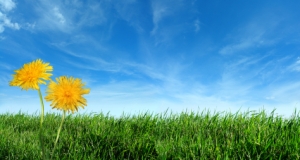
I was shopping at Lowes last weekend, and something caught my eye. From the contents of the seasonal aisle it seems that Lowes is expecting a large number of people to be using herbicides this spring. On their lawns.
When I was young I did my fair share of lawn care for different people. I don’t remember poison ever being part of the program. So now I find myself wondering. How has it come to pass that herbicide is seen as, or in any case is certainly marketed as, a standard tool in the lawn care kit? Am I to believe that the general use of ‘selective’ herbicides constitutes an advance in how we take care of our lawns?
My thoughts turn to a major object of the herbicidal campaign: dandelions. Maria Treben, a best-selling Austrian author on herbs writes that dandelions are “Nature’s greatest healing aid for suffering mankind.” Every part of the plant is thought to have healing properties—especially in the spring. [But beware: before eating dandelion, make sure that it has not, alas, been sprayed with herbicide.]
Perhaps we can reflect anew on the goal or purpose of having lawns, as well as on how our lawn care is an expression of our broader approach to the natural world. We might then be in a better position to consider what constitutes a real threat to our lawns, and to us.
Originally posted at Bacon from Acorns.


5 comments
John Cuddeback
Stephanie, I think you have an excellent point. And so does Xenophon. In the sixteenth section of his great work Oeconomicus (‘The Estate Manager’), he writes:
“For you’ll gain more produce by sowing and planting what the land readily grows and nurtures than by sowing and planting what you want.” It seems that we are missing an ancient insight.
Stephanie Shogren
Commonly accepted lawn care practices indeed represent a major trend towards thoughtlessness. In my region, eastern Pennsylvania, there are basically no native grasses. All grasses used for lawns are European in decent, which means they are ill suited for our climate, especially our scorching summers. We pour gallons of water, pesticides, and herbicides into our lawns just to keep them green. Why? Because we think we should have a lawn, and its greenery and texture are a point of pride. I think an ecological approach would be a healthier and more responsible use of our land. What thrives in your region naturally? What would contribute the the local environment? For instance, in every area there are plants that are key and sometimes sole hosts to native moths, butterflies, and praying mantises. Although it certainly won’t solve all problems, I think people in general would benefit from planting what naturally thrives rather than trying to control the lives of their dying lawn and its imposing weeds.
John Cuddeback
I think you are right that it is partly a regional thing. At the same time it seems that there has been a universal shift toward more frequent herbicide use, presumably connected to ‘advances’ in this technology. I am struck by the sheer amount of herbicide on the shelves in our stores. Ironically, today outside my office the air is filled with smell of herbicide, just sprayed on the lawns where I work. Little signs are posted by the lawn ‘care’ company: stay off the grass until dry. Can I really have confidence that once this stuff is dry it is no longer deleterious to human (and other animals’) health? Wouldn’t a pro/con analysis raise the issue of the possibility of negative health consequences?
Mark C
Perhaps it is a partly a regional thing? I grew up in suburban Colorado and pesticides/herbicides were not part of the standard lawn care toolbox. Dandelions were “pulled”. These days I live in west Texas where maintaining a yard seems to be a lot more difficult and the chemicals flow much more freely. I cringe when I see flocks of birds feasting on the bugs in the neighbor’s lawn after they have poured so much chemical on it.
John Gorentz
I’m older than you and I can’t think of a time when pesticides and herbicides were not used as lawn care weapons. I’m from the 3rd generation of a family of conscientious objectors in that war, though, and I don’t know just when pre-emergent herbicides started to be used on lawns. Google is so far refusing to divulge that information.
Comments are closed.